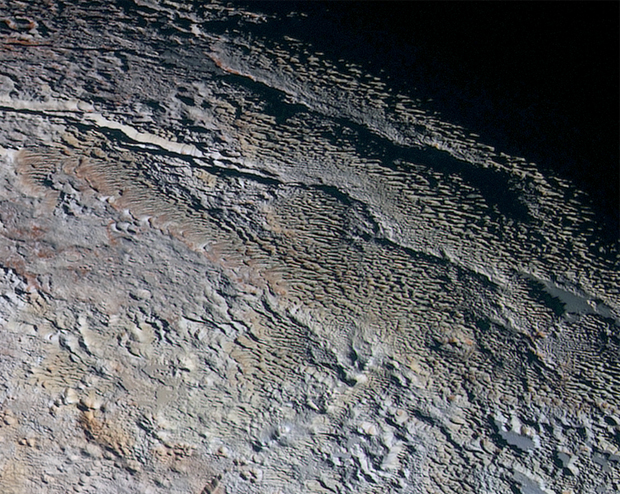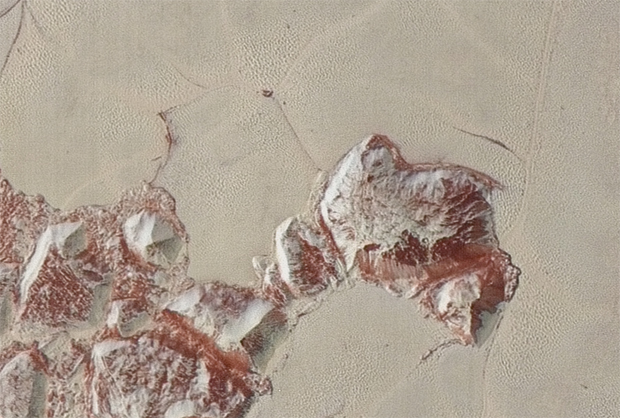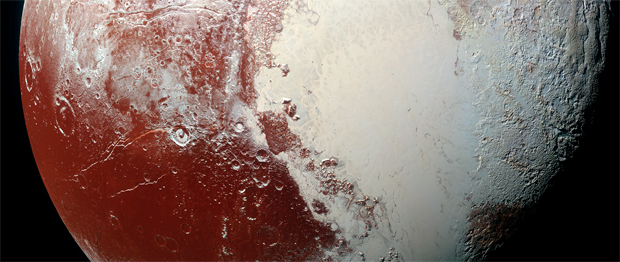New Pluto pictures astonish scientists -- again
Of the spectacular new images sent back of Pluto from NASA's New Horizons July 14 flyby of the icy dwarf planet, perhaps most stunning is a color mosaic made up of the high-resolution images transmitted back to date.
It shows a nearly full globe, allowing viewers to zoom in on features across the surface, from dark, cratered terrains and ice mountains to the smooth, frozen plains marking the now-familiar "heart" of Pluto, dubbed Sputnik Planum, to the strangely ridged terrain that so far defies explanation.
"It's a unique and perplexing landscape stretching over hundreds of miles," William McKinnon, New Horizons Geology, Geophysics and Imaging (GGI) team deputy lead, said in a NASA release describing the ridged terrain.
"It looks more like tree bark or dragon scales than geology," he said. "This'll really take time to figure out. Maybe it's some combination of internal tectonic forces and ice sublimation driven by Pluto's faint sunlight."
A new high-resolution view reveals unusual linear ridges stretching across hundreds of miles, along with deep canyons and smooth plains blanketed by sharp shadows from the strange-looking ridges:
Another picture, the highest-resolution image yet returned by New Horizons, shows dune-like structures in what a NASA description said appears to be a "shrinking glacial ice lake" along with nearby "fractured, angular water ice mountains with sheer cliffs."
The near-global map, in cylindrical projection, is not yet complete, but it adds another powerful tool for scientists to begin understanding the structure and evolution of Pluto's intriguing surface. An equally stunning, zoomable nearly-full globe view shows the planet as it might appear to an astronaut on final approach.
"Pluto's surface colors were enhanced in this (cylindrical projection) view to reveal subtle details in a rainbow of pale blues, yellows, oranges and deep reds," said John Spencer, a GGI deputy lead. "Many landforms have their own distinct colors, telling a wonderfully complex geological and climatological story that we have only just begun to decode."
Along with the new pictures, the New Horizons team provided a map showing the distribution of methane ice across the part of Pluto's surface that has been seen to date. Sputnik Planum, a bright, smooth plain, shows relatively high concentrations as do brighter crater rims and ridges. No methane shows up inside deep craters or across the dwarf planet's darker regions.
Scientists do not yet know whether the methane somehow favors the brighter areas or if the ice makes the regions bright to begin with.
"It's like the classic chicken-or-egg problem," Will Grundy, New Horizons surface composition team lead, said in the NASA release. "We're unsure why this is so, but the cool thing is that New Horizons has the ability to make exquisite compositional maps across the surface of Pluto, and that'll be crucial to resolving how enigmatic Pluto works."
Said Alan Stern, the New Horizons principal investigator: "I wish Pluto's discoverer Clyde Tombaugh had lived to see this day."
New Horizons flew past Pluto on July 14 and as of Thursday was 72 days and more than 53 million miles beyond the dwarf planet.
Because of the vast distances involved -- more than 3 billion miles -- the size of the spacecraft's antenna and the power of its transmitters, it will take more than a year and a half for New Horizons to beam back all of its stored imagery and data. The science team is releasing selected photos every week or so as new images come in.





